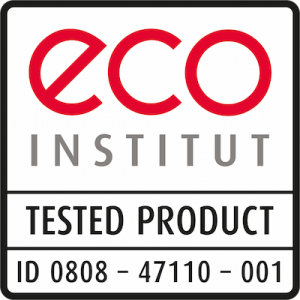The European REACH Regulation governs the registration, evaluation, authorisation and restriction of chemical substances. What obligations does this impose on manufacturers? What services does eco-INSTITUT offer in relation to REACH? And how does the eco-INSTITUT-Label take into account the requirements of the regulation? Our paper – originally published in German in our eco blog on March 30th, 2022, provides information on this.
The European REACH Regulation is Regulation (EC) No 1907/2006 concerning the Registration, Evaluation, Authorisation and Restriction of Chemicals (REACH). The aim of the regulation is that chemicals should in principle be produced and used in such a way that negative effects on humans and the environment are kept to a minimum.
In principle, the REACH regulation distinguishes between substances and mixtures of substances and so-called products. The latter are defined as “an object which, during production, is given a specific shape, surface or design which determines its function to a greater extent than its chemical composition”. However, the demarcation between the categories is not always straightforward.
Obligations for manufacturers
For manufacturers of all kinds of products, the REACH regulation can lead to rights and obligations towards the wider supply chain and towards the consumer. For example, registration obligations for chemical substances: Manufacturers may only place chemical substances of which they produce more than 1 tonne/year on the market if they have previously been registered with the EU chemicals agency ECHA. However, this only applies to the substances themselves or to mixtures of substances, not to products (there are, however, registration obligations for substances in products under certain conditions).
In addition, there are information and notification obligations in the supply chain and towards the consumer: Here, the safety data sheet is the central communication instrument. In the case of substances and mixtures of substances, the safety data sheet must always be made available to the recipient without being requested if
- the substance or mixture is classified as hazardous (according to the CLP Regulation),
- the substance is persistent and bioaccumulative and toxic or very persistent and very bioaccumulative, or
- the substance is listed on the REACH candidate list of substances of very high concern (SVHC).
In the case of products, notification obligations along the supply chain apply to commercial customers if the product contains a substance on the SVHC candidate list with more than 0.1% by mass (private end users, on the other hand, only have to be informed on request). The information can – but does not have to – be provided by means of a safety data sheet.
eco-INSTITUT provides support around the topic of REACH
With chemical expertise, eco-INSTITUT supports manufacturers in understanding and correctly implementing the requirements of the REACH Regulation. However, we do not issue REACH certificates or REACH declarations of conformity – such documents are also not provided for under the REACH Regulation (see also https://www.reach-clp-biozid-helpdesk.de/DE/Home/REACH-Zertifikate/REACH-Zertifikate.html).
Our services in detail:
- Support in strategic planning for the information obligation according to Article 33 REACH Regulation for products
- Plausibility checks of supplier information on ingredients in articles
- Plausibility checks of supplier information and safety data sheets of mixtures and substances
- Support in own supplier communication (“asking the right questions”)
- Material categorisation and development of a probability-based testing strategy
- Sample testing of supplier products and mixtures
- Support in the definition/calculation of the respective REACH reference quantity for products
- Support in the preparation of REACH information sheets for products
 eco-INSTITUT-Label and the REACH regulation
eco-INSTITUT-Label and the REACH regulation
The REACH Regulation also plays a role in the certification with the eco-INSTITUT-Label. A product can only be admitted for certification according to the eco-INSTITUT-Label criteria if it does not contain any substances with certain hazard characteristics, no substances subject to authorisation and no substances on the REACH Candidate List. This is checked within the framework of the so-called documentary check on the basis of manufacturer information on the input substances.
In the case of homogeneous mixtures of substances (e.g. paints), the document check is carried out on the basis of the declared formulation. In the case of individual substances with a content > 0.1 mass percent, their respective safety data sheets are checked and, if necessary, compared with the ECHA database in which all registered substances are listed. To check the certifiability of products, the materials used are examined on the basis of technical data sheets or – in the case of chemical input substances – on the basis of the safety data sheets.
In the event of ambiguities in the document review, specific laboratory tests may also be performed in order to clarify questions of composition. The documentary check is carried out – like the laboratory test – every 2 years when the certification is renewed. If laboratory results indicate a non-conformity of the composition, the document review is carried out again and a statement from the manufacturer is obtained. It is also contractually agreed that the manufacturer will inform eco-INSTITUT in the event of changes in materials, suppliers or production and that the product composition will be reassessed if necessary.
For more information on the eco-INSTITUT-Label, check out www.eco-institut-label.de
Author: Daniel Tigges
